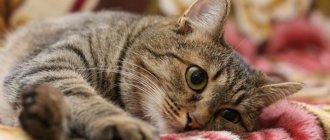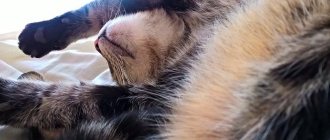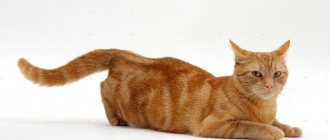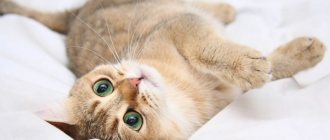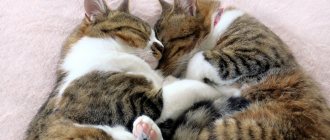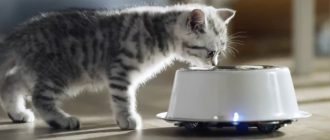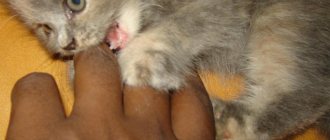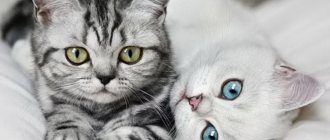11672Pavel
1
Estrus in British cats is the first problem that everyone who decides to have this breed faces. In such a situation, pets can easily cope on their own, of course, if there are no deviations.
Estrus for all cats begins at approximately the same period and progresses almost the same. Therefore, you should not panic and just contact your veterinarian for help. He will provide you with advice and recommendations on all issues that interest you.
What to do if the cat does not leak
The absence of estrus is not evidence of any serious diseases in the body.
The characteristics of the breed must also be taken into account. In order to “wake up” the female’s body, the following measures can be taken:
- Take into your home another cat that is in heat. Observing another individual, she will begin to imitate her habits, which will give impetus to the restoration of hormonal balance and the beginning of natural estrus.
- You can also accommodate a cat. Communication with the opposite sex should awaken dormant instincts and contribute to the production of enzymes that help start the process of procreation.
If the measures taken do not lead to the desired result, then it is necessary to examine the animal in a veterinary clinic. The data obtained will help the doctor select medications and a vitamin complex that will restore the cat’s reproductive function.
What can affect the timing?
Sometimes owners overreact to the fact that a cat’s first heat occurs ahead of schedule, perceiving it as a pathology. It wouldn’t be a bad idea to show your pet to a veterinarian, but you need to remember that the body of each animal develops in the same individual rhythm as a human’s, so there may be many other reasons for early maturation.
The period when an animal first showed signs of sexual anxiety may be influenced by the following factors:
- cat breed;
- nutritional features;
- heredity;
- conditions of detention;
- certain medications and vitamin therapy;
- past illnesses.
Veterinarians claim that such a failure does not in any way affect the general condition of the pet and cannot affect its reproductive health in the future. But in order to exclude the possibility of tumors of the genital organs or serious hormonal imbalance, the animal should be shown to a specialist.
Use of hormone-based medications
Mustachioed pets cope with this difficult time in different ways. Some need a little affection and attention to survive this period, while others suffer from unsatisfied desire, despite the efforts of their owners. If the usual methods of calming down are powerless, you will have to turn to special means, tablets, drops, options that help relieve tension. When mating is not planned, sterilization is the right option.
The principle of operation of drugs of this type
Only hormones, natural or synthesized, can effectively influence the onset of sexual heat. Progesterone enters the body during pregnancy. A dose of progestin preparations administered during the rest period suppresses the effect of follicle-stimulating hormone. Estrogen, which provokes sexual desire, does not enter the blood, and the period of sexual desire is blocked. If hormonal medications are used incorrectly, your pet may die.
Types of drugs
Hormonal preparations of this type are available in tablet form, as drops for internal use or application to the withers. An effective, high-quality product contains a complex of hormones. Veterinarians often prescribe the following:
- “Stop-intim”, drops based on megestrol acetate, a synthetic analogue of progesterol, given orally with a treat, sugar or forcibly;
- “Contrasex”, drops, tablets containing synthetic hormones acetomepregenol, ethinyl estradiol;
- “Gestrenol” is a complex biohormonal preparation in the form of drops and tablets;
- “Sex barrier” - mepregenol acetate plus ethinyl estradiol, liquid, tablets;
- “Ovostop” is a complex of megestrol, proroxan, melatonin, drops on the withers.
Such drugs cannot be considered harmless drugs. Before starting use, you must carefully read the instructions.
Features of application
For health and safety reasons, it is best to consult your veterinarian first. Hormones are prescribed only to healthy animals; they are administered in strict accordance with the instructions. Progestins have many contraindications; a non-specialist cannot determine them by eye. You should not skip a dose or increase the dose to compensate for the missed dose of medication.
Non-extended-release medications must be taken for the entire prescribed period. Determining the dosage is the task of the veterinarian. Spontaneous use of hormonal contraceptives is unacceptable. It is forbidden to use progestin preparations during sexual heat, this is after the end of the active phase.
Hormones do not replace the sterilization procedure; their purpose is:
- delay the onset of the active phase if pregnancy is contraindicated for your pet for some time, after recent childbirth, cesarean section, gynecological problems;
- adjust the mating time, for example, until a suitable male is found;
- prevent pregnancy if immediate sterilization is contraindicated.
Within 24 hours after an unwanted mating, progestins can prevent unplanned pregnancy.
How to determine the right day
Taking hormonal drugs in the active phase will be a disaster for the cat. The third day of the period is considered critical; the process enters the active phase. Many females experience a quiet, mild estrus, which begins almost asymptomatically.
An inexperienced owner may not pay attention to the signs: Murka becomes thoughtful and affectionate. An important point is the behavior when stroking the sacrum. The pet characteristically arches, throws back its tail, sexual activity is in full swing, progestins cannot be given. When there is no such reaction, the use of the medicine is acceptable.
Hormonal injections
The veterinarian sometimes recommends a hormone injection using a long-acting drug. Usually it is Covinan or Depo-Provera. The first is based on proligestone (synthetic progesterone), a steroid that inhibits the processes in the animal’s body that cause sexual desire, reducing the concentration of luteinizing hormone.
After discontinuation of the drug, fertility is restored. Injections are given according to a strict schedule to minimize side effects. If diarrhea, vomiting, or undesirable effects occur, the drug is discontinued.
Depo-Provera was originally developed as a female contraceptive, but has found use in veterinary medicine. The basis of the drug is medroxyprogesterone, a synthetic substance that can suppress ovulation. Available in the form of suspension and tablets. These medications should absolutely not be used during estrus. At the end of use, the ability to produce offspring is restored.
What to do if a cat yells when it wants a cat?
A cat that wants a cat makes everyone in the house nervous. She screams so loudly that it is impossible to ignore her screams. Often the owners do not even manage to fall asleep. What to do in this case? There are several ways to solve the problem:
- castration;
- use of special drugs;
- mating with a cat.
The choice of method depends on the breeder's plans. If the animal is not intended to reproduce, castration is the best solution. Otherwise, unwanted symptoms can be combated with sedatives or hormonal drugs, if mating is not planned during this period.
Sedatives for cats
The safest for cats' health are sedatives. They help reduce the female's arousal and reduce the intensity of estrus symptoms. To correct your pet’s behavior, the following medications are used:
- "Cat Baiyun". Available in tablets and liquid form. It is used in cases where cats are stressed, as well as to suppress sexual heat.
- "Fitex". A sedative in drops. The medicine is based on extracts of various plants that have an anti-stress effect.
- Cat mint. The smell of this herb calms cats. It can be placed in places where the animal spends most of its time. Catnip is also available in spray form.
- "Stop stress." A powerful sedative for cats. Available in tablets and drops. The medicine quickly suppresses sexual desire and reduces the cat's activity.
Hormonal drugs: pros and cons
To eliminate the symptoms of estrus, many breeders buy hormonal medications for cats. The most popular in this group are the following:
- "Covinan";
- "Sex Barrier";
- "CounterSex Neo";
- "Stop sex."
The drugs quickly suppress natural instincts, as they change the hormonal levels in the pets’ body, but they cannot be given for a long time. According to some veterinarians, as a result of abuse of these drugs, animals develop malignant tumors in the uterus, ovaries, and mammary glands. Some cats are diagnosed with pyometra after using hormonal medications.
Castration of a cat
During castration, a female's ovaries and uterus are removed. It is no longer possible to restore reproductive function after surgery. Such cats cannot become pregnant. However, if castration was carried out during the period of estrus, then sexual desire may persist for some time after the procedure. This is due to the action of hormones that remain in the blood.
Veterinarians recommend castrating cats before their first estrus. The surgery not only prevents cat behavior, but also prevents cancer of the reproductive organs. In addition, spayed females live longer than cats that give birth.
The operation is performed under general anesthesia. Modern materials allow you to apply sutures that do not need to be removed later. For 3–5 days, the pet must be carefully monitored, its jumping and movements must be controlled so that the seams do not come apart. When the animal recovers, its behavior will be the same. The cat will never suffer from hormonal surges again.
Developments
Let’s say a person hasn’t thought about this possibility, but he also doesn’t have much desire to have kittens. This is correct, considering how difficult it is today to place furry beauties, especially if they do not have a pedigree. Let's now count how many times a year a cat goes into heat.
The classic option is every three months. That is, they are able to bear offspring 3-4 times a year. Typically, this pattern is observed in mated animals. If she hasn't walked yet, then the frequency may be higher. Here everything is also individual: for some once a month, for others every two weeks. Of course, animals react to them differently. Some very vigorously express their desire to procreate, others behave more calmly. But in any case, not everyone can endure antics several times a month.
Clothes for spring and autumn
When your little one gets older, start teaching him to go for walks while he is awake. At the same time, he can sleep in a stroller on the balcony when the walk does not take place for some reason. Having figured out when you can start walking with your newborn baby in the autumn-spring, it would not be a bad idea to dwell on what form of clothing you should give preference to. During the off-season, the weather can change very quickly, and that gentle sun in which you went for a walk can suddenly turn into a piercing wind. For this reason, when going for a walk, you need to be prepared for any weather surprises. Clothing should be waterproof and well protected from the wind.
Duration and frequency of estrus
Some individuals with hereditary or hormonal characteristics walk for 14 days, which greatly exhausts not only themselves, but also their owners.
A successfully mated female calms down 1-2 days after meeting the cat - she ovulates and fertilization occurs. In this case, she reacts aggressively to the cat immediately after mating is completed and does not allow him near her anymore.
The cat's first heat after giving birth will occur 2.5-3 months later if the birth was successful and she nursed the kittens for 1.5-2 months. If the kittens died or were immediately taken away for some reason, then the female walks for the first time after giving birth 2-3 weeks later.
shutterstock
There are often cases when kittens are still suckling milk, but the mother is already walking and becomes pregnant again - this happens if the animal has free access to the street or constantly lives in the yard.
An important question that concerns many owners is how often do cats walk?
In the case of regular pregnancy and childbirth, the cat goes for walks 2-4 times a year, because she still needs time to bear and feed her offspring.
It is categorically not recommended to breed an animal every time it comes into heat if the owners value the health of the pet, because she needs to be given rest and time to recuperate - it is best to skip one or two heats.
A cat that does not have access to a male cat goes for walks every 2-3 months, but often this cycle is greatly shortened, and a new heat occurs 2-3 weeks after the previous one.
Possible problems
- After a cat is in heat, a false pregnancy may occur. This sometimes happens if there has been contact with a cat or a pregnant female lives nearby. Then the pet begins to experience all the symptoms of pregnancy, with the only difference being that she does not have kittens in her belly. Gradually, this condition goes away on its own, but if it recurs regularly, it is worth taking the animal to the veterinarian.
- Heat occurs too often. If pregnancy does not occur, this state of affairs will most likely lead to inflammatory processes in the uterus, mammary glands, or even a cancerous tumor.
- Estrus has stopped or has been absent for a long time. There may be several reasons for this. The most obvious one is that the pet is expecting kittens. But there is a possibility of some pathologies that should be excluded by contacting a veterinarian.
- Prolonged heat, which lasts more than 2-3 weeks, may also indicate that something is wrong with your health. These can be both hormonal disorders and disturbances in the functioning of the ovaries.
How to tell if a cat is begging for a cat
And then the question arises: how to recognize the symptoms of cat puberty in time? This is not at all difficult to do because, first of all, her behavior begins to change dramatically at any age. If you look closely at the animal, you can see the following changes:
- it begins to pay a lot of attention to the men who live in the apartment or come to visit. Requires attention and asks for affection. The pet rubs against various objects, swings on the floor and exposes its belly to be stroked. But sometimes it happens the other way around - instead of affection, the cat shows incredible aggression against the owner.
- Some females at this age, when they want to go for a walk, begin to carefully care for their genitals. They lick them well and often.
- Sometimes you can also experience loss of appetite. During this period, the pet eats much less or refuses to eat altogether, but this symptom must be taken into account when it is accompanied by a number of other signs. After all, loss of appetite may indicate the presence of many other diseases, and not just the fact that Murka wants to go for a walk.
- She yells unpleasantly and loudly. These cries may even seem completely unusual to the owner when the cat begins to walk for the first time. But you shouldn’t be afraid of them at all. They should be perceived quite normally, since with them the female calls the cat to her.
- During the period of heat, a representative of the feline family begins to mark the territory. The exact reason for this behavior has not yet been established, but there are still two explanations for this. Some experts believe that in this way she wants to attract the cat. And others, on the contrary, argue that by this the female wants to show him that this is her territory and it is not worth laying claim to it at all.
- When a cat starts asking for a cat, she urinates frequently. These urges to go to the toilet are associated with her special changes that occur at this age during the period of maturation. And don't be surprised if she urinates anywhere.
- The fact that the cat has started walking is also indicated by its posture. She lies down and lifts her hindquarters slightly upward and also moves her tail to the side. In this way, the female shows the male that she wants to go for a walk and is ready to mate.
It’s also worth knowing that a cat’s heat can be completely asymptomatic at any age, if the animal has health problems.
Planned matings
Around this age, you need to decide whether you will use your pet for breeding. Very often people make mistakes with good intentions. Believing that a cat needs to become a mother at least once, they allow a meeting with a cat. Get ready for the fact that after this the cat will wreak havoc at home and look for any crack to escape into the street every time she goes into heat.
Animals lack parental affection; they have no need to raise and care for their offspring. The cat won't feel bad because she doesn't have kittens. On the contrary, indiscriminate mating on the street is fraught with sexually transmitted diseases, injuries and other problems. Add here complications during childbirth, possible cesarean section, and the risk of developing mammary cancer, which is higher in animals that give birth. Put it all together and you will understand that it is much easier and better for your pet (and for you) to sterilize it on time.
Knowing how many times a year a cat goes into heat, you can easily multiply the amount of discomfort caused and understand that sterilization is really a good solution. This operation cannot be performed on a kitten, because it may impair the development of the animal. After reaching six months of age, discuss this issue with your veterinarian. Usually the first heat lasts only two to three days and does not cause much trouble. The animal's sexual attraction is not yet very pronounced. If sterilization is performed at this age, then you don’t have to read any further. The problem ceases to exist for you.
At what age do cats start walking? Statistics
Average data states that the need for male attention arises in cats at seven to ten months.
Physiological maturity in cats occurs at the age of eight to ten months. Rarely does this process last up to a year. If your pet goes on a spree at seven to nine months, don’t rush to breed him! Physiological and actual maturity are completely different concepts.
The phase of puberty in cats varies between 6-9 months; in some individuals, the timing may shift upward by several months. In any case, the first heat should begin before the age of 1 year; later it is considered an unhealthy deviation. It’s not at all difficult to understand that a cat has begun to “want”.
The onset of estrus is characterized by the following signs:
- Loud purring, turning into guttural calling cries.
- Frequent urination, reluctance to go to the litter box, marking the territory.
- Adopting characteristic poses with squatting on the front paws and protruding the tail upward.
- Excessive affection: following on the heels of the owners, “wiping” around the legs, excessive affection.
- Swelling of the genitals, accompanied by clear discharge. As a result, the cat begins to lick itself more often.
- Decreased appetite up to its complete loss.
- The desire to escape from home, interest in open doors and windows.
The listed signs can manifest themselves either partially or complexly, making the life of the people around them simply unbearable.
Important: there is the concept of “erased estrus”, when the animal, on the contrary, does not experience any visible symptoms characteristic of the heat stage. In such cases, it is recommended to consult a veterinarian to find out whether this indicates some kind of disorder in the body or is simply a consequence of a weak temperament.
It is important to understand when a cat becomes sexually mature. Veterinarians believe that this occurs as early as 6–7 months of age, with females beginning puberty much earlier than males. There are a number of factors that influence exactly when a cat starts walking:
- diet of the animal;
- climate;
- habitat.
It is believed that short-haired animals mature much earlier than long-haired animals. If we talk about periods, that is, the number of days, then on average for each cat this happens at least 2 times a year. This is a rather arbitrary indicator, since in most cases the process occurs much more often.
Typically, cats' first heat begins in early spring. This is especially true for outbred animals, because they have such a periodicity inherent in nature. Therefore, if a pet was born in autumn or winter, it may want to go for walks when it has barely reached six months of age.
It would seem that only recently the fluffy little ball was playing with a ball of thread, but after 6 - 8 months of life, the cat has entered puberty and is ready to become a mother. Around this time, the owners are faced with the animal's first heat. It is difficult to notice an estrus, the symptoms lie exclusively in behavior - excessive affection, persistent cries, the cat fawns, takes a characteristic position for mating (falls on its front paws).
It is difficult to answer the question of how long cats walk, especially for the first time, with specific numbers. Each animal will have its own characteristics. Which can only be calculated by observing the sexual cycle of your pet. In addition, one cannot ignore environmental conditions, namely the nature of nutrition and maintenance, and the breed of the cat.
How many times do cats go for walks? In animals that live outside or older pets, the onset of estrus is associated with the seasons, usually spring and autumn. For cats that constantly live in an apartment and do not leave its confines, or take short walks in the country, more frequent estrus is typical, which can be explained by comfortable living conditions. The average interval between estrus in a healthy animal is 15–25 days, but there are exceptions and features.
Duration of estrus in different breeds
There are many features of estrus in different types of cats. It should be remembered that most animals are bred artificially using genetic engineering, which involves crossing different breeds.
In some animals, the first heat begins at 6–10 months, but the ability to mate comes to them a little later. Through numerous trials and errors, experienced owners of purebred animals realized that during the first estrus the cat is not yet ready to become a mother. Even if pregnancy occurs, in most cases it ends in difficult childbirth or the birth of dead kittens.
The main features of estrus in animals of different breeds:
- 1. Scottish fold
. The female's first estrus begins at the age of 10–12 months. The ideal mating period to increase your chances of getting pregnant is the second heat. The cat walks 3-4 times a year for 5-7 days. After mating - 2 times a year. - 2. British
. It first begins to walk at the age of 10–12 months, usually in the spring. Subsequently, estrus in British females occurs twice a year (in spring and autumn) and lasts a long time - from 4 to 14 days. If the kitten has already given birth, then her next estrus will begin a month after the end of feeding the kittens. - 3. Persian
. The first estrus in females begins at the age of 6 months. At this time, the cat is not yet ready for contact with the male due to the underdevelopment of the genital organs. Her estrus lasts from 3 days to one week, and the regularity depends on the individual characteristics of the body. If a Persian cat is never mated to a male cat, she will come into heat every 14 days. - 4. Siamese
. Females of this breed walk from 5 to 7 days every month. As the female gets older, she asks for the cat less and less. The difference between this breed is that estrus is asymptomatic, so owners cannot always understand when the cat is ready to mate. This is especially true for animals that are overweight. Usually the first heat in Siamese cats occurs at the age of one and a half years. - 5. Sphinx
. It should be remembered that these exotic cats become very irritable and uncontrollable during the period of heat. Estrus in sphinxes occurs from 1 year to 5-6 days with a frequency of 1 month. - 6. Maine Coon
. In females of this breed, puberty occurs much later than others. On average, the first estrus in Maine Coons occurs between 10 months and a year.
It is necessary to take into account the fact that if during estrus the female does not become pregnant, then she will have a period of calm, the duration of which depends on the individual characteristics of the animal.
The reproductive cycle is a neurohumoral reflex process that occurs with the manifestation of a complex of physiological and morphological changes in the female genital organs. Sexual cycles appear with the advent of physiological maturity and continue with a certain frequency until old age.
One of the most noticeable phases of the reproductive cycle for owners is estrus.
Cat owners who still have small pets want to know at what age cats can walk in order to properly prepare for this process.
The article will answer the question “at what age does a cat ask for a cat?”, talk about the differences between physiological and actual sexual maturity, give recommendations for mating, and talk about the sterilization procedure.
When does the first heat start in British cats?
The first heat in a British cat, like many other breeds, begins at 7 months.
Therefore, there is no need to worry, you just need to prepare for this period. After a British cat goes into heat for the first time, the process of puberty occurs. During this period, the females begin to actively demand a male, but there is no need to rush into this. The animal must wait a little, because at this age the body is not yet ready for the mating process. This should be done only after a year, it is during this difficult period that she is ready to conceive and bear offspring.
© shutterstock
The first heat in a British cat is possible at 7-9 months. But, as a rule, no one can indicate an exact period, because everything depends on the conditions of keeping the animal. Also, premature estrus can be caused by a cat that has been neutered and if he climbs somewhere nearby.
Alternative ways to resolve the heat issue
Modern pharmacology can offer pet owners to discourage their animals from any desire to flirt with the opposite sex, preserving their reproductive function. In this case, it is proposed to use two types of drops:
- Sedatives (in addition to ready-made pharmacy options, you can use folk methods in the form of chamomile or thyme decoctions);
- Hormonal (they will calm a walking animal by adjusting the animal’s hormonal levels).
If the animal is not valuable as a breeder, it is better not to torture it and castrate the cat. Unlike people, animals do not grieve over the loss of the opportunity to bear offspring, so the pet will not receive any mental trauma, but only peace for itself and its owners.
What to do if your pet goes on a spree?
Firstly, be mentally prepared for the need to feed kittens on your own. Practice, unfortunately, proves that such cats almost always lose milk. This is due to a sharp change in hormonal levels. The released compounds block the synthesis of prolactin, that is, the hormone responsible for milk production. Accordingly, the kittens are left without their natural food.
Let us immediately warn you that you should never use cow or goat milk to feed babies, since their characteristics are very different from cat milk and often cause severe digestive disorders. And for small kittens the latter are deadly.
Secondly, under no circumstances use hormonal medications to stop estrus. The body of an animal that has gone into heat immediately after birth is already experiencing powerful overloads. There is no need to aggravate the matter with an influx of “third-party” hormones of synthetic origin. In such cases, the matter may end in oncology.
Consult your veterinarian and choose more gentle sedative drugs on a natural basis. They will allow you and your cat to safely survive the hunting period.
Stages of the reproductive cycle
The reproductive cycle of all females, regardless of breed, is divided into 4 stages.
Proestrus is the beginning of estrus and lasts about two days. During this period, if there is a cat in the house, the cat makes inviting sounds and fawns over him
In the absence of a male, he turns all his attention to the owner, follows him everywhere, rubs against his legs and purrs. Estrus is the peak of excitement. In different breeds it ranges from 4 to 12 days
If the female does not have a partner for mating, then she begins to rub herself against any object she comes across, the meowing becomes so loud that not all owners are ready to calmly tolerate the sounds made, and when stroking the animal takes a pose of readiness for mating. Interestrus - the time after mating, ranges from 4 to 19 days; during this period, if fertilization has occurred, the cat does not allow the male to approach her, since sexual hunting stops. If conception does not take place, then a new wave of activity will repeat after 10-14 days. Anestrus is the period of time between estrus when the animal is at rest, that is, its normal state.
Age at first estrus in cats
For most cats, the first heat begins after the female reaches a weight of 2.5 kg. This rule does not apply to large breeds such as Maine Coon or British cats.
The age of puberty ranges from 4 months to 1.5 years. Most often, a cat first begins to ask for a cat at 6-9 months. This age depends on several factors:
- Heredity.
Some cats are more temperamental than others, and some, on the contrary, are late maturing. In mixed breeds, the onset of the first heat is difficult to predict in advance, but among purebreds, patterns have already been identified.
The fastest maturing are the short-haired “oriental” breeds - Thai, Siamese, Burmese, Abyssinians, Bengals, Cornish Rex. On the other hand, cats of long-haired breeds sometimes begin to walk at 10-12 months and later - Persian, Maine Coon, Siberian.
Young cat of the Bengal breed
- Daylight hours.
March cats are not a fiction. Increasing the duration of daylight hours encourages the onset of estrus. If the cat is six months old in the spring, you should expect the onset of estrus soon. If the same age falls in October-December, then the onset of estrus is more likely only next spring.
In an apartment, this dependence hardly manifests itself due to constant heat and constant artificial lighting.
- Conditions of detention.
Exhausted cats lacking vitamins and fats do not go into heat. Therefore, street animals mature later than domestic animals, and their estrus occurs less frequently.
- Communication with relatives.
The presence of another cat in heat or an unneutered cat provokes the onset of heat in young teenage cats.
To delay the onset of the first heat as much as possible, the owner needs to keep the cat isolated in the apartment and turn on the light for no more than 4-6 hours a day.
How often does a cat go for walks?
The duration of estrus in cats is variable and depends on many factors: breed, age, living conditions, diet, individual physiological characteristics, etc. Due to the hormonal background not yet fully formed, the first estrus is most often short-lived. Subsequent cycles occur over a longer period, taking an average of 5-7 days.
You can find out how often your cat will go for walks by carefully observing its behavior. To do this, it is recommended to keep a special diary in which you need to record all the results. In nulliparous individuals, estrus can occur quite frequently - once a month, sometimes even every two weeks. This is especially true for purebred cats that live exclusively in a home environment and do not roam outside. In stray yard animals, as well as elderly “retired women,” the cycle is usually tied to the time of year - spring and autumn. The first heat after childbirth can begin within 1-1.5 months.
How long can a British cat go into heat?
In order to determine how long the period of festivities for a given breed can last, it is worth taking a closer look at the chronology of this event:
- When talking about how long a British cat’s estrus can last, they most often start from the moment of obvious signs such as uterine cries. In fact, it’s worth taking a closer look at the animal from the moment it eats more than usual, cuddles up to its owner, and often worries. In the British breed, like any other, this period usually does not last long - about a day or two.
- The next stage lasts on average 5-7 days. It was during this period that all the “heavy artillery” described above fell.
However, it should also be mentioned how long the very first heat lasts. It can be only 4-5 days. Therefore, in this case there is no need to worry - everything is within normal limits.
How to relieve symptoms of estrus
No cat owner, even the most patient, can like the fact that both day and night his pet, who has entered the breeding age, howls, bites and is overly active and aggressive. At such moments, the question arises of what to do with a cat whose antics can no longer be tolerated.
The easiest way to resolve the issue is to arrange a “date” for the tailed brawler with a suitable cat.
It should be taken into account that you need to choose the most suitable time for mating. The peak of sexual activity in animals whose age allows them to reproduce occurs between February and March. It is at this time that it is more advisable to have offspring, guided by the simplest logic. In the coming summer months there will be no problems with obtaining food for the babies, the cubs do not need to be protected from the cold, and by the first serious frost they will already have reached adulthood.
This path is suitable for owners of purebred animals and those whose cats, having entered adulthood, walk on their own and live in the courtyard of a private house. In a city apartment, a low-bred wild animal can hardly become a prominent and sought-after gentleman. In this case, it is necessary to consider other ways to resolve the issue.
What is estrus in a cat?
Estrus, estrus, heat are the names of the state when the female’s body is ready for mating, bearing, and giving birth to offspring. The body undergoes natural endocrine changes caused by the maturation of follicles in the ovaries. The external manifestations, duration, and frequency of this condition are difficult to predict; they depend on various factors. But understanding your pet’s condition will bring undoubted benefits.
Signs and symptoms
Although the symptoms of this process manifest themselves differently in each Murka, you must definitely learn to identify them. The onset is determined by the following characteristic features:
- enlargement of the genitals;
- the appearance of special bloodless discharge;
- increased frequency of urination;
- an increase in the number of licks;
- decreased appetite;
- more affectionate or aggressive behavior;
- frequent attempts to go for a walk;
- characteristic unpleasant sounds.
Whether all symptoms appear simultaneously or only some depends on the individual characteristics of the animal. The pet can roll on the floor, wriggle, throw its tail to the side, howl deep in its throat, make screams, i.e. do everything possible to attract a male and begin reproducing offspring.
For her, this is completely natural behavior, which seems strange and illogical to the owner. There are other manifestations: screaming, constantly meowing, marking territory, walking past the toilet, ignoring the litter tray, eating poorly, not eating anything, sleeping a lot, losing weight, peeing on the bed.
How does the furry beauty feel?
Changes in the endocrine background cause changes in emotions. The condition of the reproductive organs changes. The brain receives signals that significantly change the pet’s behavior. The situation becomes unusual and stressful. The cat begins to worry and feels the need for affection. An increase in stress levels provokes instinctively aggressive behavior, furious meowing. When Murka's puberty proceeds normally, the baby is not in pain, but her anxiety increases noticeably, and she may lose weight due to nervousness.
How often does estrus occur?
Breeders note that the frequency of cycles depends on the breed, more often in temperamental ones, less often in calm ones. The first include the Siamese and Persians, the second - the British and Scots. There are other factors: time of year, childbirth, age, hormonal changes, health status. It is necessary to take into account the individual characteristics of each individual. In cats of the same breed and age, periods of arousal differ markedly.
How long does it last
The duration of estrus is individual for each individual. Usually it lasts only a few days, sometimes it lasts two weeks, twenty days. Felinologists recommend carefully monitoring the process, recording the duration of each rut, and marking the dates on the calendar. Sudden changes in timing indicate trouble. Prolonged sexual activity is a characteristic symptom of problems with the ovaries: cysts, tumors, inflammation. A reduction in the timing of the rut occurs with hormonal problems, expressed in thyroid pathologies, abnormal development of the ovaries.
Seasonality of the reproductive cycle
The time of year affects the frequency of heat in cats. In spring, summer, and autumn, the desire to mate increases, in winter it decreases. It is necessary to take into account the conditions of detention; permanent residence in a warm house blurs the lines between seasons; the female is ready to mate regardless of the season. This is an individual moment. One Murka expresses a desire to mate at the very beginning of spring, the other - closer to the beginning of summer. With age, the seasonality of the reproductive cycle changes. If Murka is healthy, there is no need to worry.
Frequency of estrus
How many times and exactly when the process starts depends on:
- childbirth and feeding, after which half a year or less may pass until the next active phase;
- death of kittens or early weaning after birth, which reduces the break until the next active phase;
- age, the desire to mate becomes less as the female ages.
One heat cycle every three months, i.e. four per year is considered the average norm. There are cats that are ready to mate every month or more often; for some, one date with a male every six months is enough.
If there has been mating, the desired pregnancy has occurred, estrus will stop for the duration of gestation, i.e. for two months or a little more. The next active phase occurs 3-5 months after birth or earlier if the offspring was stillborn.
How to determine if a cat is in heat?
Scottish cats are considered a breed of average sexuality. However, all females are different. Among the Scottish there are those who throw real fireworks, if they are not satisfied, with climbing almost onto the chandelier and singing trumpet trills.
The author's 6-month-old Scottish cat, during her heat, climbed onto a coat rack in the hallway and, having picked up all her things, screamed loudly. After that, she tore off the cornice and curtain from the window, made her way into the wardrobe and tore up all the things, crawling under the “roof”. Then she continued to call the cat from there. This was repeated every 2 weeks for 3 months until the owners sterilized her.
In the usual case, if a Scottish cat wants a cat, she becomes affectionate and more affectionate, rubs against objects and the owner, meows, pulls her butt up, and bends her tail to the side. But she may not pull her butt, especially the first time or if she is not stroked on the back below the waist, which excites the female - then she begins to exhibit sexual behavior, also stamping her paws, as during mating. However, usually, even in a mild heat, the cat rolls around on the floor, as if in bliss, turning from side to side.
In addition, excited females have transparent discharge from their private parts that is visible to the naked eye. If you see them, this is normal. That is why this period is called estrus. But there should be no bloody or any other color discharge: if they suddenly appear, it’s time to sound the alarm and run to the vet.
Also worth knowing: cats during heat, including the Scottish breed, can mark their territory, although this is rare. This behavior is especially typical for females that have not been bred for a long time. The solution is either regular mating or sterilization.
